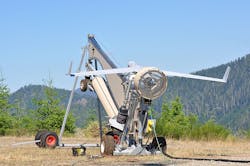Insitu unmanned aircraft demonstrate UAS benefits in fire monitoring, firefighting
BINGEN, Wash., 9 Sept. 2015.Insitu Rapid Response team members launched a ScanEagle unmanned aircraft, also known as a UAS, UAV, or drone, into the hazy skies above the Paradise Fire in Washington’s Olympic National Park, as part of an operational demonstration of how unmanned aircraft technology can be a powerful force multiplier in the fight against wildfires.
ScanEagle Surveillance - Paradise Fire Olympic National Park, Washington, USA from Insitu on Vimeo.
ScanEagle flew six operations, delivering more than 37 hours of infrared video in real time to Incident Command personnel. Insitu’s suite of motion imagery software provided enhanced video and geo-registration capabilities that enabled fire officials to pinpoint the fire’s perimeter and identify areas of intense heat. ScanEagle also assisted helicopter assets with evaluating water drop locations.
“This and other planned unmanned aircraft systems demonstrations will serve to guide our policies, procedures and requirements for the safe, phased integration of UAS in support of wildfire management,” explains Mark Bathrick, director, U.S. Department of the Interior, Office of Aviation Services. “These demonstrations are part of a larger interagency strategy aimed at employing UAS to provide firefighters on the ground with time-sensitive information that will give them the highest level of situational awareness and support possible.”
“We are honored to support the individuals who are risking their lives to protect the natural resources endangered by wildfires in the Pacific Northwest,” says Insitu President and CEO Ryan M. Hartman. “This exercise demonstrated our ability to collect, process, and deliver information that helps fire officials achieve better outcomes.”
ScanEagle flew within an emergency certificate of authorization (ECOA) issued to the Department of Interior from the FAA that permitted its operation within the confines of the temporary flight restriction.
With offices in the U.S., U.K., and Australia, Insitu creates and supports unmanned systems and software technology that deliver end-to-end solutions for collecting, processing, and understanding sensor data. A wholly owned subsidiary of The Boeing Company, Insitu serves the diverse needs of global customers in the military, commercial, and civil industries. To date, Insitu systems accumulated more than 842,000 operational flight hours and 104,000 sorties.
You might also like:
Subscribe today to receive all the latest aerospace technology and engineering news, delivered directly to your e-mail inbox twice a week (Tuesdays and Thursdays). Sign upfor your free subscription to the Intelligent Inbox e-newsletter at http://www.intelligent-aerospace.com/subscribe.html.
Connect with Intelligent Aerospace on social media: Twitter (@IntelligentAero), LinkedIn,Google+, and Instagram.

